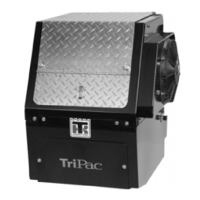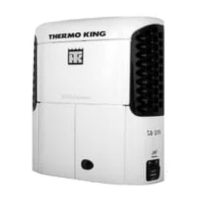Do you have a question about the Thermo King MAGNUM and is the answer not in the manual?
General safety guidelines for operating and handling the unit.
Precautions for handling refrigerant oil safely and first aid measures.
Safety measures to prevent electrical shock hazards during servicing.
Procedures to prevent damage to sensitive electronic components from ESD.
Safe procedures for refrigerant recovery to protect the environment.
Cooling capacity data for various conditions for MAGNUM models.
Details on electrical components, motors, and power requirements.
Data on compressor, refrigerant charge, and system pressures.
Technical details of the MP-3000a controller including defrost and modes.
Dimensions, weight, and physical characteristics of the unit.
Torque specifications for metric bolts used in unit assembly.
Overview of the MAGNUM unit's design, construction, and basic features.
Description of the scroll compressor's digital and intermediate suction ports.
Function of the economizer system for subcooling refrigerant and improving efficiency.
Details on thermistor-type sensors used for temperature monitoring.
Description of the microprocessor-controlled fresh air management system.
Display of sensor temperature and status indicator LEDs on the controller.
Explanation of the controller keypad functions for navigation and input.
Keys used to navigate controller menus, submenus, and enter commands.
Operation of the unit's main power switch for turning the unit on and off.
Procedure for adjusting the unit's temperature setpoint via the controller.
Steps to manually start a defrost cycle for the evaporator coil.
Accessing and viewing general unit operating information via the controller.
Displays current communication status with a REFCON system.
List of functions to display unit operating information recorded in the datalogger.
Accessing tests like PTI, Function Test, and Power Management.
Procedure for a quick pretrip test to check unit functions.
How to perform tests on individual unit components.
Performing diagnostic tests on specific components or systems.
Setting power limits to reduce total unit electric power consumption.
Using manual control in case of controller failure for unit operation.
How the AFAM system controls air exchange rates and vent door position.
How the Economy mode reduces power consumption by adjusting fan operation.
Procedures and conditions for initiating and terminating defrost cycles.
How the MP-3000a data logger records and stores operational data.
Steps to update or install controller software via flash loading.
Procedures for removing and installing a replacement controller.
How the controller auto-configures based on installed unit options.
Location and function of the main power circuit breaker.
Function, testing, and specifications of the high pressure cutout switch.
Function and removal/installation of the low pressure cutout switch.
Troubleshooting steps for malfunctioning electric heater elements.
Methods for detecting refrigerant leaks in the system.
How to inspect the receiver tank sight glass to check refrigerant level.
Steps for evacuating the refrigeration system to remove moisture and air.
Procedures for charging the system with R-404A refrigerant by weight.
Steps for removing and installing a compressor.
Steps for replacing the filter drier or in-line filter.
Procedures for replacing the evaporator expansion valve.
Procedures for replacing the economizer heat exchanger.
Steps for replacing the receiver tank or water-cooled condenser tank.
Procedures for replacing the vapor injection valve.
Steps for replacing the compressor digital control valve.
Methods for cleaning the condenser coil and inspecting the grille.
How to adjust the fresh air exchange system's vent door for ventilation rates.
Overview of using the MP-3000a controller for diagnosing unit problems.
Common mechanical issues, their causes, and remedies.
Common refrigeration issues, their causes, and remedies.
Explains status messages displayed by the controller and corresponding actions.
Detailed list of alarm codes, their descriptions, and corrective actions.
Identification of the scroll compressor in the system diagram.
Identification of the evaporator coil in the system diagram.
Guide to navigating and setting parameters within the controller's Setpoint menu.
Guide to accessing and interpreting alarm codes from the controller.
Guide to viewing unit operating data on the controller display.
Guide to accessing diagnostic tests and commands via the controller.
General safety guidelines for operating and handling the unit.
Precautions for handling refrigerant oil safely and first aid measures.
Safety measures to prevent electrical shock hazards during servicing.
Procedures to prevent damage to sensitive electronic components from ESD.
Safe procedures for refrigerant recovery to protect the environment.
Cooling capacity data for various conditions for MAGNUM models.
Details on electrical components, motors, and power requirements.
Data on compressor, refrigerant charge, and system pressures.
Technical details of the MP-3000a controller including defrost and modes.
Dimensions, weight, and physical characteristics of the unit.
Torque specifications for metric bolts used in unit assembly.
Overview of the MAGNUM unit's design, construction, and basic features.
Description of the scroll compressor's digital and intermediate suction ports.
Function of the economizer system for subcooling refrigerant and improving efficiency.
Details on thermistor-type sensors used for temperature monitoring.
Description of the microprocessor-controlled fresh air management system.
Display of sensor temperature and status indicator LEDs on the controller.
Explanation of the controller keypad functions for navigation and input.
Keys used to navigate controller menus, submenus, and enter commands.
Operation of the unit's main power switch for turning the unit on and off.
Procedure for adjusting the unit's temperature setpoint via the controller.
Steps to manually start a defrost cycle for the evaporator coil.
Accessing and viewing general unit operating information via the controller.
Displays current communication status with a REFCON system.
List of functions to display unit operating information recorded in the datalogger.
Accessing tests like PTI, Function Test, and Power Management.
Procedure for a quick pretrip test to check unit functions.
How to perform tests on individual unit components.
Performing diagnostic tests on specific components or systems.
Setting power limits to reduce total unit electric power consumption.
Using manual control in case of controller failure for unit operation.
How the AFAM system controls air exchange rates and vent door position.
How the Economy mode reduces power consumption by adjusting fan operation.
Procedures and conditions for initiating and terminating defrost cycles.
How the MP-3000a data logger records and stores operational data.
Steps to update or install controller software via flash loading.
Procedures for removing and installing a replacement controller.
How the controller auto-configures based on installed unit options.
Location and function of the main power circuit breaker.
Function, testing, and specifications of the high pressure cutout switch.
Function and removal/installation of the low pressure cutout switch.
Troubleshooting steps for malfunctioning electric heater elements.
Methods for detecting refrigerant leaks in the system.
How to inspect the receiver tank sight glass to check refrigerant level.
Steps for evacuating the refrigeration system to remove moisture and air.
Procedures for charging the system with R-404A refrigerant by weight.
Steps for removing and installing a compressor.
Steps for replacing the filter drier or in-line filter.
Procedures for replacing the evaporator expansion valve.
Procedures for replacing the economizer heat exchanger.
Steps for replacing the receiver tank or water-cooled condenser tank.
Procedures for replacing the vapor injection valve.
Steps for replacing the compressor digital control valve.
Methods for cleaning the condenser coil and inspecting the grille.
How to adjust the fresh air exchange system's vent door for ventilation rates.
Overview of using the MP-3000a controller for diagnosing unit problems.
Common mechanical issues, their causes, and remedies.
Common refrigeration issues, their causes, and remedies.
Explains status messages displayed by the controller and corresponding actions.
Detailed list of alarm codes, their descriptions, and corrective actions.
Identification of the scroll compressor in the system diagram.
Identification of the evaporator coil in the system diagram.
Guide to navigating and setting parameters within the controller's Setpoint menu.
Guide to accessing and interpreting alarm codes from the controller.
Guide to viewing unit operating data on the controller display.
Guide to accessing diagnostic tests and commands via the controller.
| Brand | Thermo King |
|---|---|
| Model | MAGNUM |
| Category | Air Conditioner |
| Language | English |












